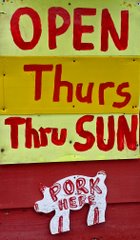
Despite the very cold (well, very cold for Georgia) temps, I bundled up the kids into the minivan and we headed out for our "farmer food" run--in other words, our CSA delivery.
I am still amazed at the amount of beautiful, local produce available year-round. This week, my delivery included a dozen eggs, spinach, chard, sweet potatoes, apples, 2 different kinds of lettuce, a half-dozen homemade muffins, a gorgeous-smelling bar of lavender goats-milk soap, baby radishes, a big pile of unshelled pecans, an herbal sachet, and Asian baby turnips.
My last pickup a couple weeks ago (during the winter the CSA is on an every-other-week schedule) didn't include any lettuce, because the unseasonably cold weather and heavy rains we had at the last minute washed out the crops that might otherwise have been available. I have grown addicted to the sweet, tender lettuces I've gotten in my CSA deliveries, so it's a welcome sight to have them back in my box of goodies this week.
I never thought I would rave over something as simple as lettuce, but I can't help it--the taste comparison between the local lettuces--especially the Bibb--and the bagged greens I used to grab at Kroger aren't even close to being in the same league. The bagged lettuces taste like styrofoam to me now, and I find I'd rather wait until my CSA greens are available to have my salads and eat them, too.
Another nice thing about local winter greens is that the cold brings out a delicate sweetness in the greens that makes them quite different than their late summer-early fall counterparts.
There were only a few radishes, not enough to try the cream of radish soup I was thinking of trying, so this batch will get sliced thin and used in the above-mentioned salads--although I tasted some amazing pickled radish last year--I think it was at Canoe--and I would love to replicate it, but so far haven't managed that yet. Tried a recipe last year, but the result was too, well, pickled---it didn't have that sweetness of the ones I'd previously had, or the subtle crunch and fresh taste. Any recipes out there would be GREATLY appreciated.

The muffins are half-gone already--Sam, my 2 year old, started stealing them off the counter before I had finished taking the photos for this blog. I joined in quickly thereafter. The boy has good taste--they were quite yummy.
The chard is a gimme--I always do the same thing with it, which is follow Alice Waters' simple but ridiculously good recipe for Chard with Parmesan from her must-have cookbook, the Art of Simple Food:
Pull the leaves from the ribs of one or more bunches of chard. Discard the ribs (or save them for another dish), wash the leaves, and cook until tender in abundant salted boiling water, 4 minutes or so. Drain the leaves, cool, squeeze out most of their excess water, and chop coarse. For every bunch of chard, melt three tablespoons of butter in a heavy panover medium heat. Add the chopped chard and salt to taste. Heat through and for each bunch of chard stir in a generous handful of freshly gratedParmesan cheese. Remove from the heat and serve.
SOOOOOO goood. Again, never thought I would be having rhapsodies over chard, of all things, but I am starting to have a clue as to why Barbara Kingsolver chose rainbow chard as her can't-live-without favorite food.
As for the turnips, not a clue yet. They're pretty, though. Right now I'm admiring them--food as art. Need to figure out something for them before they turn into food as garbage. Inventiveness with turnips is new for me.

The apples will be devoured raw--no recipe needed. Those puppies are just too awesome to bypass in their natural state.
The pecans are going to require a shelling party, possibly this weekend. I'll probably freeze a bunch of them, although some sort of pecan coffee cake may be in the works. I'll let you know. I'm thinking of glazing a bunch of them, too, to be used in my salads. Yum.
The eggs will be used like, well, eggs. I get a kick out of these eggs, though--they range in color from brown to white to blue, and the yolks from pale yellow to this gorgeous shade of saffron that makes beautiful scrambled eggs. One of the best discoveries I've made since making a concerted effort to eat local foods is the range of colors, textures, and tastes of a single food. In a grocery store, even an organic store, the eggs would all be uniform in shape, color, and size. I had no idea fresh eggs could come in such a lovely shade of blue. It continues to be a lovely surprise.
The spinach has been my green of choice to be piled on my lunchtime sandwich and eaten raw. It also responds well to being sauteed in butter and olive oil just until it wilts, then gently tossed with a generous amount of salt and pepper, dried cranberries and tasted walnuts or pecans.
So that's the take for today. More to come as I figure out what to do with all this goodness.

